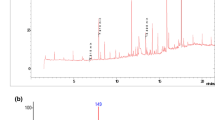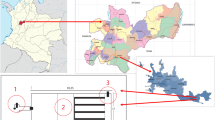Abstract
Polyhexamethylene biguanide (PHMB), a biocide used in a wide variety of disinfection and preservation applications, is a polydisperse mixture in which the end-groups may be any combination of amine, guanidine and cyanoguanidine. Using PHMB model compounds (1,6-diaminohexane; 1,6-diguanidinohexane; 1,6-di(cyanoguanidino)hexane; 4-guanidinobutyric acid), we have determined the biodegradation characteristics of each end-group in several strains of bacteria isolated for their ability to utilise PHMB as a sole source of nitrogen. Bacteria were screened for growth at the expense of each model compound (at non-inhibitory concentrations) as sole nitrogen source. None of the isolated bacteria was capable of utilising a cyanoguanidine end-group as growth substrate, whereas several bacteria were shown to utilise amine or guanidine end-groups. In particular, a strain of Pseudomonas putida was capable of extensive growth with 1,6-diguanidinohexane as a sole nitrogen source, with complete removal of guanidine groups from culture medium within 2 days, and with concomitant formation of unsubstituted urea, which in turn was also utilised by the organism. We conclude that whilst amine and guanidine end-groups in PHMB are likely to be susceptible to biodegradation, cyanoguanidine end-groups are likely to be recalcitrant.





Similar content being viewed by others
References
Allen MJ, Morby AP, White GF (2004) Cooperativity in the binding of the cationic biocide polyhexamethylene biguanide to nucleic acids. Biochem Biophys Res Commun 318:397–404
Altschul SF, Madden TL, Schäffer AA, Zhang J, Zhang Z, Miller W, Lipman DJ (1997) Gapped BLAST and PSI-BLAST: a new generation of protein database search programs. Nucleic Acids Res 25:3389–3402
Archibald RM (1944) Determination of citrulline and allantoin and demonstration of citrulline in blood plasma. J Biol Chem 156:121–142
Ausubel F, Brent R, Kingston RE, Moore DD, Seidman JG, Smith JA, Struhil K (1994) Current protocols in molecular biology. Wiley, New York
Boethling RS (1996) Designing biodegradable chemicals. ACS Symp Ser 640:156–171
Brandl H, Aeberli B, Bachofen R, Schwegler I, Muller HM, Burger MH, Hoffmann T, Lengweiler UD, Seebach D (1995). Biodegradation of cyclic and substituted linear oligomers of poly(3-hydroxybutyrate). Can J Microbiol 41(Suppl 1):180–186
Broxton P, Woodcock PM, Heatley F, Gilbert P (1984) Interaction of some polyhexamethylene biguanides and membrane phospholipids in Escherichia coli. J Appl Bacteriol 57:115–124
Cervantes FJ, Dijksma W, Duong-Dac T, Ivanova A, Lettinga G, Field JA (2001) Anaerobic mineralization of toluene by enriched sediments with quinones and humus as terminal electron acceptors. Appl Environ Microbiol 67:4471–4478
Collins CH, Patricia ML (1984) Microbial methods. Butterworth, London
Cunin R, Glansdorff N, Piérard A, Stalon V (1986) Biosynthesis and metabolism of arginine in bacteria. Microbiol Rev 50:314–352
Cutler RA, Diana GD, Schalit S (1966) Bisbiguanides, a new series of antimicrobial agents. Soap Chem Spec 2:45–49
Dean-Raymond D, Alexander M (1977) Bacterial metabolism of quaternary ammonium compounds. Appl Environ Microbiol 33:1037–1041
East GC, McIntyre JE, Shao J (1997) Polybiguanides: synthesis and characterization of polybiguanides containing hexamethylene groups. Polymer 38:3973–3984
European Union (2000) Common core data set for active substances and biocidal products. In: Technical guidance document in support of the directive 99/8/EC concerning the placing of biocidal products on the market—guidance on data requirements for active substances and biocidal products, version 4.3.2, pp 27–49
van Ginkel CG (1995) Biodegradation of cationic surfactants. In: Porter MR, Karsa RD (eds) Biodegradability of surfactants. Blackie Academic and Professional, London, pp 183–203
Hundal RS, Inzucchi SE (2003) Metformin: new understandings, new uses. Drugs 63:1879–1894
Mackrell JA, Walker JRL (1978) The biodegradation of quaternary ammonium compounds. Int Biodet Bull 14:77–83
Marchesi JR, Sato T, Weightman AJ, Martin TA, Fry JC, Hiom SJ, Wade WG (1998) Design and evaluation of useful bacterium-specific PCR primers that amplify genes coding for bacterial 16S rRNA. Appl Environ Microbiol 64:795–799
McDonnell G, Russell AD (1999) Antiseptics and disinfectants: activity, action and resistance. Clin Microbiol Rev 12:147–179
Kapich AN, Jensen KA, Hammel KE (1999) Peroxy radicals are potential agents of lignin biodegradation. FEBS Lett 461:115–119
Pelmont J, Barrelle M, Hauteville M, Gamba D, Romdhane M, Dardas A, Beguin C (1985) A new bacterial dehydrogenase oxidizing the lignin model compound guaiacylglycerol beta-O-4-guaiacyl ether. FEMS Microbiol Lett 48:109–113
Powers EM (1995) Efficiency of the RYU non-staining KOH technique for rapidly determining Gram reactions of food-borne and waterborne bacteria and yeasts. Appl Environ Microbiol 61:3756–3758
Prescott LM, Jones ME (1969) Modified methods for the determination of carbamyl aspartate. Anal Biochem 32:408–419
Rose FL, Swain G (1954) Polymeric diguanidines. UK Patent 702,268
Rose FL, Swain G (1956) Bisdiguanidines having antimicrobial activity. J Chem Soc IV:4422–4425
Rosenberg H, Ennor AH, Morrison JF (1956) The estimation of arginine. Biochem J 63:153–159
Shoeb SM, Hirota M, Shimizu E, Yorifuji T (1994) Diguanidinobutane (arcaine) degradation in Rhodococcus sp. C-x. Biosci Biotechnol Biochem 58:859–863
Stacklebrandt E, Goebel BM (1994) Taxonomic note: a place for DNA–DNA re-association and 16S rRNA sequence analysis in the present species definition in bacteriology. Int J Syst Bacteriol 44:846–849
Tricot C, Piérard A, Stalon V (1990) Comparative studies on the degradation of guanidino and ureido compounds by Pseudomonas. J Gen Microbiol 136:2307–2317
White GF (1995) Biodegradation of surfactants. In: Morpeth FF (ed) Preservation of surfactant formulations. Blackie Academic and Professional, Glasgow, pp 83–117
Yorifuji T, Kaneoke M, Shimizu E, Shiota K, Matsuo R (1989) Degradation of α,ω-diguanidinoalkanes and a novel enzyme, diguanidinobutane amidinohydrolase in Pseudomonas putida. Agric Biol Chem 53:3003–3009
Acknowledgements
This work received support from Avecia Biocides (now Arch Biocides) in the form of chemicals and a studentship to LPOM.
Author information
Authors and Affiliations
Corresponding author
Rights and permissions
About this article
Cite this article
O’Malley, L.P., Collins, A.N. & White, G.F. Biodegradability of end-groups of the biocide polyhexamethylene biguanide (PHMB) assessed using model compounds. J IND MICROBIOL BIOTECHNOL 33, 677–684 (2006). https://doi.org/10.1007/s10295-006-0103-6
Received:
Accepted:
Published:
Issue Date:
DOI: https://doi.org/10.1007/s10295-006-0103-6




